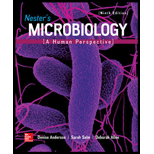
Nester's Microbiology: A Human Perspective
9th Edition
ISBN: 9781259709999
Author: Denise G. Anderson Lecturer, Sarah Salm, Deborah Allen
Publisher: McGraw-Hill Education
expand_more
expand_more
format_list_bulleted
Concept explainers
Textbook Question
Chapter 2, Problem 5MC
Pure water has all of the following properties except
a) polarity.
b) ability to dissolve lipids.
c) pH of 7.
d) covalent joining of its atoms.
e) ability to form hydrogen bonds.
Expert Solution & Answer
Want to see the full answer?
Check out a sample textbook solution
Students have asked these similar questions
Briefly state the physical meaning of the electrocapillary equation (Lippman equation).
Explain in a small summary how:
What genetic information can be obtained from a Punnet square? What genetic information cannot be determined from a Punnet square?
Why might a Punnet Square be beneficial to understanding genetics/inheritance?
In a small summary write down:
Chapter 2 Solutions
Nester's Microbiology: A Human Perspective
Ch. 2 - Differentiate between an atom, a molecule, and a...Ch. 2 -
2. Why is water a good solvent?
Ch. 2 - Which solution is more acidic, one with a pH of 4...Ch. 2 - Prob. 4SACh. 2 - Prob. 5SACh. 2 - What is a structural isomer?Ch. 2 - Name the major groups of lipids and give an...Ch. 2 - List six functions of proteins.Ch. 2 -
9. What are the four levels of protein structure,...Ch. 2 - How do DNA and RNA differ from one another in...
Ch. 2 - Choose the list that goes from the lightest to the...Ch. 2 -
2. An oxygen atom has an atomic number of 8. It...Ch. 2 - Dehydration synthesis is involved in the synthesis...Ch. 2 - The primary structure of a protein relates to its...Ch. 2 -
5. Pure water has all of the following properties...Ch. 2 - When the pH of a solution changes from 3 to 8, the...Ch. 2 - A shortage of nitrogen (N) would make it most...Ch. 2 - Complementarity plays a major role in the...Ch. 2 - Prob. 9MCCh. 2 - The function of a buffer is to a) bring the pH of...Ch. 2 - A group of prokaryotes known as thermophiles...Ch. 2 -
2. Microorganisms use hydrogen bonds to attach to...Ch. 2 - What properties of the carbon atom make it ideal...Ch. 2 -
2. A biologist determined the amounts of several...Ch. 2 - The table on the right indicates the freezing and...
Knowledge Booster
Learn more about
Need a deep-dive on the concept behind this application? Look no further. Learn more about this topic, biology and related others by exploring similar questions and additional content below.Similar questions
- Not part of a graded assignment, from a past midtermarrow_forwardNoggin mutation: The mouse, one of the phenotypic consequences of Noggin mutationis mispatterning of the spinal cord, in the posterior region of the mouse embryo, suchthat in the hindlimb region the more ventral fates are lost, and the dorsal Pax3 domain isexpanded. (this experiment is not in the lectures).a. Hypothesis for why: What would be your hypothesis for why the ventral fatesare lost and dorsal fates expanded? Include in your answer the words notochord,BMP, SHH and either (or both of) surface ectoderm or lateral plate mesodermarrow_forwardNot part of a graded assignment, from a past midtermarrow_forward
- Explain in a flowcharts organazing the words down below: genetics Chromosomes Inheritance DNA & Genes Mutations Proteinsarrow_forwardplease helparrow_forwardWhat does the heavy dark line along collecting duct tell us about water reabsorption in this individual at this time? What does the heavy dark line along collecting duct tell us about ADH secretion in this individual at this time?arrow_forward
arrow_back_ios
SEE MORE QUESTIONS
arrow_forward_ios
Recommended textbooks for you
 Human Biology (MindTap Course List)BiologyISBN:9781305112100Author:Cecie Starr, Beverly McMillanPublisher:Cengage Learning
Human Biology (MindTap Course List)BiologyISBN:9781305112100Author:Cecie Starr, Beverly McMillanPublisher:Cengage Learning Biology Today and Tomorrow without Physiology (Mi...BiologyISBN:9781305117396Author:Cecie Starr, Christine Evers, Lisa StarrPublisher:Cengage Learning
Biology Today and Tomorrow without Physiology (Mi...BiologyISBN:9781305117396Author:Cecie Starr, Christine Evers, Lisa StarrPublisher:Cengage Learning Biology (MindTap Course List)BiologyISBN:9781337392938Author:Eldra Solomon, Charles Martin, Diana W. Martin, Linda R. BergPublisher:Cengage Learning
Biology (MindTap Course List)BiologyISBN:9781337392938Author:Eldra Solomon, Charles Martin, Diana W. Martin, Linda R. BergPublisher:Cengage Learning


Human Biology (MindTap Course List)
Biology
ISBN:9781305112100
Author:Cecie Starr, Beverly McMillan
Publisher:Cengage Learning

Biology Today and Tomorrow without Physiology (Mi...
Biology
ISBN:9781305117396
Author:Cecie Starr, Christine Evers, Lisa Starr
Publisher:Cengage Learning

Biology (MindTap Course List)
Biology
ISBN:9781337392938
Author:Eldra Solomon, Charles Martin, Diana W. Martin, Linda R. Berg
Publisher:Cengage Learning


Macromolecules | Classes and Functions; Author: 2 Minute Classroom;https://www.youtube.com/watch?v=V5hhrDFo8Vk;License: Standard youtube license